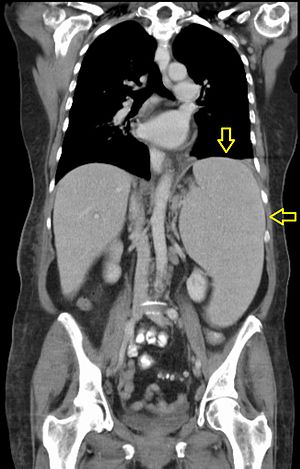Splenitis
| Splenomegaly | |
|---|---|
 |
|
| CT scan in a patient with chronic lymphocytic leukemia, showing splenomegaly. Yellow arrows point at the spleen. | |
| Classification and external resources | |
| Specialty | General surgery |
| ICD-10 | Q89.0, R16.1 |
| ICD-9-CM | 759.0, 789.2 |
| DiseasesDB | 12375 |
| MedlinePlus | 003276 |
| eMedicine | ped/2139 med/2156 |
| MeSH | D013163 |
Splenomegaly is an enlargement of the spleen. The spleen usually lies in the left upper quadrant (LUQ) of the human abdomen. Splenomegaly is one of the four cardinal signs of hypersplenism which include; some reduction in the number of circulating blood cells affecting granulocytes, erythrocytes or platelets in any combination, a compensatory proliferative response in the bone marrow, and the potential for correction of these abnormalities by splenectomy. Splenomegaly is usually associated with increased workload (such as in hemolytic anemias), which suggests that it is a response to hyperfunction. It is therefore not surprising that splenomegaly is associated with any disease process that involves abnormal red blood cells being destroyed in the spleen. Other common causes include congestion due to portal hypertension and infiltration by leukemias and lymphomas. Thus, the finding of an enlarged spleen, along with caput medusa, is an important sign of portal hypertension.
The standard system for classifying splenomegaly on radiography is:
Also, a cutoff of a craniocaudal height of 13 cm is also used to define splenomegaly.
Splenomegaly refers strictly to spleen enlargement, and is distinct from hypersplenism, which connotes overactive function by a spleen of any size. Splenomegaly and hypersplenism should not be confused. Each may be found separately, or they may coexist. Clinically if a spleen is palpable, it means it is enlarged as it has to undergo at least twofold enlargement to become palpable. However, the tip of the spleen may be palpable in a newborn baby up to 3 months of age.
Symptoms may include abdominal pain, chest pain, chest pain similar to pleuritic pain when stomach, bladder or bowels are full, back pain, early satiety due to splenic encroachment, or the symptoms of anemia due to accompanying cytopenia.
...
Wikipedia
